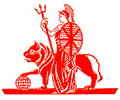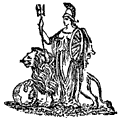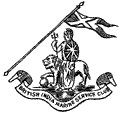FOR ALL THOSE WITH AN INTEREST IN BRITISH INDIA STEAM NAVIGATION (BI)
BI Livery & Insignia
Britannia badge from ships' stationery 1960s
Badge from a BI envelope of 1939
Device from a Calcutta letterhead used until the mid-1950s
SHIPS
The colours of British India Steam Navigation (BI) were known throughout the East and all around the India Ocean, Red Sea and Australasia. The distinctive black funnel with two white bands was the trademark of one of the most numerous fleets of the world, carrying cargoes and passengers between ports in the UK and Continent, Mediterranean wayports, Red Sea, Persian Gulf, east and South Africa, the Indian subcontinent, southeast Asia, the Far East and Australasia.The funnel was the universal symbol that topped the equally distinctive ships' livery of black hull, with narrow white band, red boot topping and stone coloured king posts and topmasts, as seen in this picture of Chilka.
From 1955, passengerships were given white hull with a black line (see home page picture), a move which was disliked by many and arguably gave away some of the unique character of BI ships. The troopships had buff funnels and white hulls with a dark blue band.
HOUSE FLAG
The BI houseflag was a a white burgee with red St Andrew's cross (above right). Although no record remains as to the origin or meaning of the flag, the book Shipping Wonders of the World did recount a yarn which, though unauthenticated, perhaps contains some of the truth: It is to the effect that the founders, Mackinnon and Mackenzie, being good Scots, instructed a flagmaker to make sets of flags for their first ships, taking the St Andrews's cross as their design and cutting a triangle from the fly to distinguish it from the national flag. One of the partners drew an outline to indicate the flag's shape and position of the cross, but the ignorant Sassenach flagmaker based the saltire on a red-on-white St Patrick's cross instead of the intended white-on-blue. Rather than waste the completed flags, the story goes, the frugal Scots adopted the design.From 1927, ships commanded by the BI commodore were distinguished by the commodore's flag -
a modified house flag (left). BI's badge consisted of a standing Britannia in front of a lion, facing left. The lion holds one paw on a globe. Controversy erupted several years ago over whether the lion should have tail extended or not.
Britannia appeared on cap badges and uniform buttons and it was BI's practice in later years to have the Britannia badge painted on ships' stems (see detail picture, right, of Chinkoa).
UNIFORMS
Uniforms for officers were prescribed by BI as early as 1863, it being one of the first companies to adopt a standard style of dress. BI, in common with many of the larger British shipping companies, had its own distinction lace for officers. BI's style was plain cuff rings for all officers, with purple insertions for engineers, green for electricians, white for pursers, red for the medical department and light blue for matrons and children's hostesses.Officers and petty officers in BI wore company uniform while on board ship with the BI-pattern lace, worn either on the cuff on blue cloth uniform or on epaulettes on white (tropical) uniform. Click on the image below for a larger version of the colour chart.
All officers wore the company's brass buttons and capbadge, with Britannia motif. The peeks of commanders' caps bore the distinctive "scrambled egg" oakleaf embroidery.
COMPANY
Like many companies with conservative traditions, the badge, flag and funnel served as BI's identity for many years but with the fashion for new corporate identities in the 1950s and 60s and the spread of the graphic arts, BI acquired its own logo design (right) which survived until within a year or two of the company's demise, when a rather ugly, albeit contemporary, deep-shadowline logo was chosen to mimic the new P&O style.
On reorganisation from 1972, as ships were transferred from BI to the newly established P&O group shipping divisions, BI ships' funnel markings were painted over, except in isolated cases, with the pale blue with white P&O logo which had been adopted as the livery for the new non-passenger divisions of the enlarged group. Thus the modern fashion for painting company logos on ships had finally caught up with British India.
(See also the history page on this site for funnel markings and house flags of companies in the the BI group)
BI's Britannia from an advertisement of 1902
Officers' capbadge from the company's Regulations and Instructions 1949
Crest of the BI Club, Bombay from a letterhead of 1948







